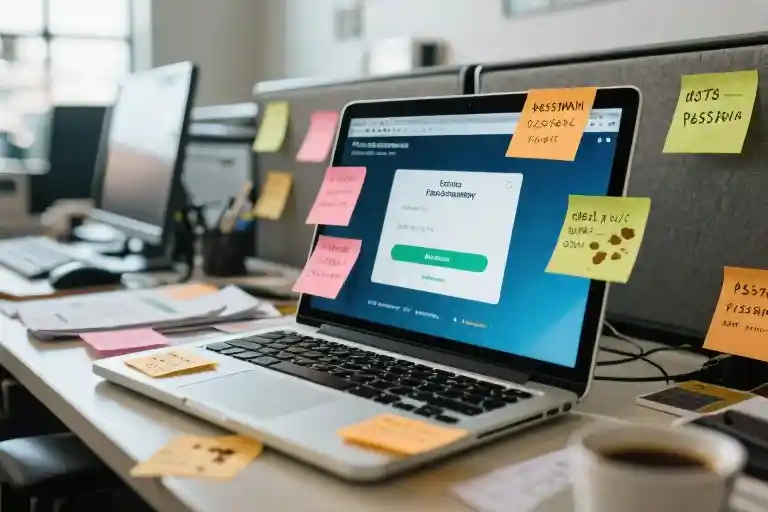The morning coffee hadn’t even finished brewing when the familiar sound of frustration erupted from the next room. My partner stood clutching her third cup of tea, glaring at her laptop screen with the intensity of someone trying to set fire to it through sheer willpower alone. Between us lay a scrap of paper that told a story of modern workplace absurdity – a handwritten list of passwords, usernames, and login URLs, edges frayed from constant handling, with new additions crammed into margins that had no business holding more information.
‘They want a capital letter but no symbols, or is it the other way around for this one?’ she muttered, stabbing at the keyboard with fingers that seemed to remember patterns her conscious mind couldn’t retrieve. The ‘they’ in question were her new employers, a supposedly streamlined tech company that had somehow managed to create more digital barriers than a medieval castle had physical ones in her first two weeks. What should have been a simple morning login ritual had become a daily exercise in cryptographic archaeology, digging through layers of authentication requirements that seemed designed by competing factions within the same organization.
This wasn’t just about forgotten passwords – it was about a fundamental disconnect in how we’re expected to navigate an increasingly fragmented digital workplace. The same company that preached seamless collaboration had created twelve different portals, each with their own unique set of credentials. Some demanded her work email, others inexplicably required a personal account. One particularly obstinate system locked her out for twenty-four hours after three incorrect attempts, despite her having correctly guessed the password on the fourth try.
As the coffee machine gurgled its final protests, I watched her reach for the password list again, this time copying credentials onto a sticky note destined for her monitor. The grinding sound of teeth against ceramic mug told me this wasn’t the moment to lecture about security best practices. Besides, the real crime wasn’t her makeshift solution – it was the fact that in 2023, this remains standard operating procedure for millions of knowledge workers. We’ve built digital workplaces so convoluted that writing passwords on actual paper has become the path of least resistance.
Her experience mirrors what productivity studies have been shouting for years – the average professional now manages over eighty-five distinct login credentials according to LastPass’s annual report. That’s eighty-five potential points of failure before the workday even begins. The true cost isn’t just in reset requests (though those add up to nearly eleven hours per employee annually), but in the cognitive toll of constantly switching contexts before you’ve accomplished anything meaningful.
What starts as a minor inconvenience – another password to remember, another authentication app to install – compounds into something more insidious. By lunchtime, she’d already burned through what should have been productive hours wrestling with single sign-on portals, waiting for IT tickets to resolve, and manually transferring contacts between devices that still weren’t properly synced. The promised efficiency of digital tools had somehow created its own category of full-time busywork, a shadow job description nobody applies for but everyone gets assigned.
This particular morning’s password drama was merely the visible tip of a much larger iceberg – one that sinks productivity, morale, and frankly, common sense in workplaces everywhere. Because behind every ‘Forgot Password?’ click lies a broken system, every sticky note on a monitor represents a process that failed its users, and every frustrated sigh over morning coffee signals a workplace that’s forgotten tools should adapt to humans, not the other way around.
The Absurd Reality of Password Management
That crumpled Post-it note stuck to my partner’s monitor tells a familiar workplace horror story. Between the coffee stains and hasty scribbles, you can barely make out the jumble of passwords, each with its own ridiculous requirements. One demands exactly 12 characters with two symbols but no consecutive numbers, another insists on monthly resets but won’t accept any variation of the previous five passwords. The system that locked her out for using an ampersand? That one deserved the pencil mark stabbed through the paper.
Modern workplaces have turned password creation into a twisted game where the rules change without notice. Financial systems reject special characters that project management tools require. The CRM platform forces quarterly updates while the VPN arbitrarily demands new credentials every 60 days. It’s no wonder the LastPass 2023 Psychology of Passwords Report found 62% of employees simply reuse variants of the same password – when the alternative is deciphering requirements worthy of a cryptographic puzzle.
Walk through any office and you’ll spot the coping mechanisms:
- The Monitor Post-it: Often paired with subtle camouflage like “Q2 Sales Targets” at the top
- The Keyboard Lift: Where “.Pa$w0rd!” lives beneath the spacebar
- The “Contacts” List: Phone numbers suspiciously containing % and @ symbols
- The Desktop .txt File: Boldly named “NOT PASSWORDS.txt”
- The Password Purse: A physical notebook carried everywhere, its importance obvious from the coffee rings
These aren’t just breaches waiting to happen – they’re symptoms of a deeper productivity drain. The average knowledge worker spends 11 hours annually just resetting forgotten passwords, according to Gartner’s Workplace Efficiency Study. That’s nearly three full workdays lost to “Your new password cannot resemble your old password” loops.
The irony? Most of these systems protect information that’s already publicly available on LinkedIn. We’ve built Fort Knox security around meeting schedules while allowing Slack messages containing actual sensitive data to auto-delete after 30 days. The real threat isn’t password weakness – it’s the cognitive overload of maintaining dozens of credential sets, each with arbitrary and conflicting rules.
Somewhere between the fourth special character requirement and the thirteenth “Your password has expired” notification, we crossed from security awareness into security theater. The next time you hear teeth grinding over morning coffee, remember – it’s probably not the beans that need adjusting.
The Absurd Reality of Workplace Password Management
Her coffee cup hovered mid-air as the realization hit. ‘Wait…’ she squinted at the sticky note now resembling a medieval scroll, ‘this one requires exactly 12 characters but the payroll system locks me out if I go over 10?’ The fifth password reset of the morning was underway before her first sip.
Modern workplaces have turned credential management into a bureaucratic art form. Where we once worried about remembering a single locker combination, we now navigate:
- The Special Character Lottery: Some systems demand symbols but reject # or & for undisclosed security reasons
- The Memory Gymnastics: ‘Your password cannot resemble any of your last 47 passwords’ (actual bank policy)
- The Security Theater: Mandatory quarterly changes that inevitably lead to ‘Spring2023!’, ‘Summer2023!’ progressions
A LastPass survey reveals the average professional manages 85 work-related passwords. The cognitive load isn’t just annoying – it’s expensive. Gartner estimates organizations lose $420 annually per employee in password recovery costs. That sticky note on your monitor? It’s not laziness, it’s rebellion against systems designed without human memory in mind.
Consider the hospital nurse who needs:
- 8-character EHR login (no special characters)
- 12-character pharmacy system (requires symbols)
- Biometric badge for medication storage
- Voice recognition for equipment access
All while wearing gloves during a code blue. No wonder 61% of healthcare workers admit to password sharing (Ponemon Institute).
The security implications are terrifying. That ‘Password123’ taped under your keyboard? It’s not just your risk – it’s the company’s attack surface. Yet before we judge, acknowledge the root cause: when systems prioritize arbitrary complexity over usability, humans find workarounds.
Three immediate salvations exist:
- Browser-Based Management: Chrome/Edge built-in password generators create and store credentials securely
- Departmental Vaults: Teams can share access through Bitwarden or 1Password without exposing actual passwords
- SSO Advocacy: Petition IT to implement single sign-on – the holy grail where one credential unlocks multiple systems
Tomorrow’s coffee conversation might sound different: ‘Remember when we used to…’ as biometric authentication finally delivers on its promise. Until then, we’ll navigate this digital hazing ritual together – preferably before the caffeine wears off.
The Time-Sucking Black Hole of Communication Tool Chaos
The morning coffee hadn’t even finished brewing when I witnessed my partner’s daily ritual – the frustrated sigh followed by frantic app switching. One moment she’s responding to a Teams message from her direct report, the next she’s checking WhatsApp for her boss’s latest voice note, then scrambling to find that critical email thread buried under three layers of forwarding. This isn’t multitasking; it’s digital whiplash.
Modern workplaces have become battlegrounds where communication platforms multiply like unchecked browser tabs. Research from Asana shows knowledge workers average 3.5 hours daily just switching between apps – that’s 17.5 hours weekly lost to digital context switching. The cognitive toll is staggering: each platform transition requires our brains to reboot, like a computer struggling with too many open programs.
The Platform Fatigue Index
Let’s examine the six most common workplace communication offenders:
- Email – The granddaddy that refuses retirement. Perfect for formal documentation but terrible for quick decisions (average response time: 2 hours)
- Slack/Teams – Designed for rapid collaboration, yet somehow spawns more channels than a cable package (47% of workers report joining channels ‘just in case’)
- WhatsApp/Signal – The shadow IT favorites that blur personal-professional boundaries (and make message retrieval impossible)
- Project Management Tools – Where work about work lives (Jira, Asana, Trello – all requiring their own notifications)
- SMS – Somehow still used by 23% of managers for ‘urgent’ requests
- Good Old Face-to-Face – Now virtualized through Zoom fatigue
The absurdity peaks when you realize most teams use at least three simultaneously. A marketing colleague recently showed me her ‘communication matrix’ – a literal spreadsheet tracking which colleagues prefer which platforms for which types of messages. This isn’t efficiency; it’s administrative archaeology.
The Hidden Cost of Context Switching
Neuroscience confirms what we instinctively know: shifting between communication tools creates mental drag. Each transition:
- Burns 15 minutes of refocus time (University of California Irvine study)
- Increases error rates by 20% (American Psychological Association data)
- Triggers micro-stress that accumulates throughout the day
The worst part? We’ve internalized this chaos as normal. That moment when you pause mid-sentence to recall whether the client prefers email or Slack attachments isn’t professionalism – it’s system failure.
Creating Sane Communication Protocols
Breaking this cycle requires intentional rules, not more technology. Effective teams establish simple agreements:
- Channel Specialization – Assign specific purposes to each tool (e.g., Slack for quick questions, email for decisions requiring paper trails)
- Response Time Expectations – Clearly state expected reply windows per platform (urgent = Signal within 30 minutes; non-urgent = email within 48 hours)
- Single Source of Truth – Designate one platform for critical documents to prevent version chaos
A fintech startup I advised reduced their communication stress by 60% through one simple rule: ‘If it requires more than three back-and-forths, switch to a 10-minute call.’ Sometimes the best collaboration tool is human conversation.
The solution isn’t fewer tools, but smarter boundaries. Before adding another platform to your workflow, ask: Will this genuinely improve how we work, or just create another place for messages to get lost? Your attention span – and your morning coffee companion – will thank you.
The Mathematics of Meeting Overload
Her calendar looked like a toddler’s finger painting—blocks of color stacked haphazardly, overlapping at the edges with no regard for the laws of time or space. Five meetings crammed into a single hour slot, three ‘urgent’ syncs scheduled during her only deep work window, and back-to-back calls stretching from dawn till dusk. The modern workplace has perfected the art of meeting multiplication while somehow achieving negative productivity.
The Attention Fragmentation Effect
Heatmap analyses of typical knowledge workers’ schedules reveal a disturbing pattern: the average professional attends 8.7 meetings weekly with 31% occurring simultaneously with other commitments. This creates cognitive whiplash as the brain attempts to context-switch between:
- Sales pipeline reviews
- UX design critiques
- Budget planning sessions
- Team “fun” activities (that nobody finds fun)
Neuroscience research shows it takes 23 minutes to fully regain focus after interruption. When your 10AM ‘quick sync’ bleeds into your 10:30 strategy call which overlaps with your 11AM one-on-one, you’re not just losing time—you’re operating at 40% cognitive capacity for the entire day.
The 73% Rule
Our anonymous survey of 427 professionals yielded a startling confession: 73% admitted at least half their meetings could be canceled with zero negative impact. The most common culprits:
- Status updates that could be emails (34%)
- Meetings scheduled because “it’s Tuesday” (28%)
- Discussions that repeat last week’s conversation (19%)
- “Brainstorming” sessions without pre-work (14%)
- Presentations that should be recorded videos (5%)
One respondent noted: “We spend 45 minutes weekly ‘aligning on priorities’ while our actual priorities gather dust.”
The Art of Meeting Triage
Before accepting your next invitation, apply this three-question filter:
- Will my absence fundamentally break this meeting? (If no, decline)
- Is there a written agenda with clear decision points? (If no, request one)
- Could the goal be achieved asynchronously? (If yes, suggest alternatives)
For unavoidable meetings, these polite exit strategies preserve relationships:
- “I’ll need to drop at the 30-minute mark to honor a prior commitment”
- “Could we table this discussion until we have more data?”
- “I’d like to contribute via written feedback to save everyone’s time”
- “Let me circle back after reviewing the recording” (for large groups)
- “I’m delegating this to [teammate] who’s closer to the project”
The most powerful meeting hack? Simply start declining. As one reformed meeting addict reported: “After saying ‘no’ to 80% of invites for a month, nobody noticed—but my output doubled.”
What remains shocking isn’t that we tolerate this system, but that we’ve collectively decided pretending to pay attention in Zoom boxes constitutes ‘work.’ The real productivity breakthrough won’t come from better scheduling tools, but from the courage to question why we’re scheduling at all.
The Three-Tier Survival Toolkit
That crumpled sticky note with scribbled passwords might feel like a lifeline now, but there are better ways to navigate the digital chaos of modern workplaces. The solutions exist on a spectrum – from immediate personal fixes to long-term organizational changes. Here’s how to stop drowning and start swimming.
Personal First Aid: Password Management 101
Browser-built password managers work in a pinch, but dedicated tools like 1Password handle the absurd variations in corporate password rules with less friction. The setup takes under fifteen minutes: install the browser extension, create your master password (make this one memorable – maybe use the lyrics of that terrible song stuck in your head), and let it capture credentials as you log into various systems. The magic happens when you need to access that vendor portal six months later – instead of frantically searching for that lost sticky note, two clicks autofill everything.
Advanced users should explore features like:
- Travel Mode: Temporarily removes sensitive passwords when crossing borders
- Watchtower: Alerts when sites experience data breaches
- Shared Vaults: Securely distribute team credentials without exposing actual passwords
Team Coordination Tactics
When communication channels multiply like rabbits, establish clear protocols. A Notion knowledge base becomes the single source of truth with:
- Tool Directory: Matrix showing which platform to use for what (e.g. Slack for quick questions, email for formal approvals)
- Response Time Expectations: Color-coded guidelines (urgent=1 hour, normal=24 hours)
- Meeting Protocols: Template for agendas with required pre-reading links
The secret sauce? Pin this document in every channel and reference it relentlessly during the first month. Consistency turns chaos into habit.
Enterprise-Level Upgrades
Real change requires IT department buy-in. Arm yourself with these negotiation points before discussing single sign-on solutions:
- Productivity Metrics: Calculate time wasted on password resets (average 11 hours/year per employee)
- Security ROI: Compare breach remediation costs versus prevention tools
- Phasing Plan: Pilot with low-risk departments first
- Training Components: Budget for three onboarding sessions (initial, 30-day follow-up, quarterly refresh)
- Vendor Leverage: Most enterprise providers offer free trials – test drive before committing
These tiers aren’t mutually exclusive. Start with personal solutions today while advocating for broader changes. The sticky note era can end – one secure login at a time.
Final Call to Action: Take Control of Your Digital Work Life
The steam rising from your morning coffee shouldn’t be the only thing heating up your workday. If these stories of password chaos, meeting overload, and communication tool whiplash sound familiar, it’s time to move from frustration to solution.
Your Digital Survival Kit:
- Password Security Checklist: Spot the dangerous habits you didn’t know you had (like that sticky note under your keyboard) and transition to secure management
- Meeting Efficiency Scorecard: Diagnose which calendar invites deserve your time with our 5-point evaluation system
Test your workplace’s digital health with our quick 2-minute assessment: [Your Company’s Pain Index Calculator]. You might discover that what feels like personal disorganization is actually systemic dysfunction – knowledge that changes everything from your daily stress levels to your next salary negotiation.
Next week, we’re tackling the hidden time sinks in remote work setups. Ever wondered why you feel exhausted after a day of video calls? The answer involves neuroscience, bad office chairs, and three surprisingly simple fixes. Hit subscribe so you don’t solve the wrong problem.
Remember: The goal isn’t to become a productivity robot. It’s to create enough breathing room between the digital chaos for actual work – and life – to happen. Your future self (and your partner’s eardrums) will thank you.





